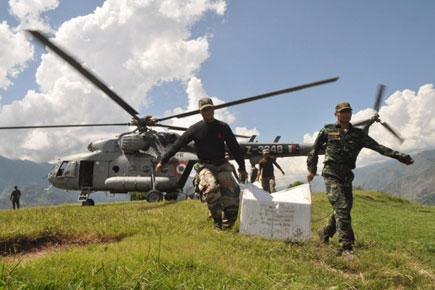The Indian military Monday scaled up its massive operation to rescue thousands marooned in Jammu and Kashmir's worst floods in 50 years that has claimed over 160 lives so far

Indian Army soldiers offload aid materials from an Indian Air Force Mi-17 helicopter during flood rescue and relief operations at Sarh in Mahore, some 170 kms from Jammu
Srinagar: The Indian military Monday scaled up its massive operation to rescue thousands marooned in Jammu and Kashmir's worst floods in 50 years that has claimed over 160 lives so far.

Indian Army soldiers offload aid materials from an Indian Air Force Mi-17 helicopter during flood rescue and relief operations at Sarh in Mahore, some 170 kms from Jammu. Pic/AFP
ADVERTISEMENT
In well coordinated efforts, the army, the navy and the air force used boats, helicopters and planes in a bid to reach out to the many thousands stranded on rooftops in Srinagar, a city now looking like a swollen Dal Lake following days of torrential rains and flash floods.
With seven more people dying in a landslide in Udhampur Monday, the death toll in a week of devastation has crossed 160, officials told IANS.
A defence ministry spokesman said that the army had rescued 23,530 people from different regions of the state.
Deploying hundreds of men for rescue and relief work, the army has distributed 5,000 blankets, 140 tents, 23,000 litres of water and 600 kg of biscuits.
Water bottles are being airlifted from Chandigarh and New Delhi. Eighty medical teams have swung into action. A total of 85 tonnes of medicines were airlifted.
Fifty-two Indian Air Force helicopters and transport aircraft have flown 140 sorties and dropped 155 tonnes of relief materials.
But officials admitted that the situation was scary and there was no contact yet with already remote areas in the Kashmir Valley now made more inaccessible due to all round destruction.
Srinagar, the summer capital of the state, remained mostly under water. The overflowing Jhelum took virtually the entire city in its grip, barring the old parts located on higher ground.
Residents told IANS that in some areas two- and three-storey houses had almost gone under water, and that thousands in Srinagar were sheltering on rooftoops hoping and praying for an early rescue.
With radio and television services crippled, with most most mobile telephones not functional, and internet connectivity dead, there were no tweets for a change from Chief Minister Omar Abdullah -- and no easy way to get in touch with senior police and civil officials.
"I have never seen anything like this," said Mohammed Ashraf, a long-time Srinagar resident. "This is like hell."
Police and the Central Reserve Police Force also joined the rescue efforts, at places transporting the marooned to safer places in their huge trucks.
On Monday, the army airlifted its communication equipment. BSNL loads were flown from Bangalore and Jammu.
Most of Srinagar's residential and commercial areas have been inundated. Residents and traders scrambled to save whatever they could from the muddy and swirling waters of the Jhelum river.
The waters have entered homes, shops, businesses, schools and colleges, hospitals, mosques and army camps. There was a sea of water at Lal Chowk, the city centre.
People plied boats on flooded streets to reach higher ground.
The only communication tool still up and running was the police wireless system.
One army officer compared the destruction to the Uttarakhand tragedy of last year when thousands died in flash floods.
Speaking on the condition of anonymity, he said it would take huge efforts to rebuild damaged roads, homes, other buildings and bridges.
The army has established shelter camps at Poonch, Rajouri, Thanamandi, Bela, Potha, Sanai, Kishtwar, Akhnoor, Budhal, Gulabgarh, Sungri, Salomé, Gul, Kandi, Samote, Mahore and Chasana areas.
Each camp is now home to 50 to nearly 1,200 homeless people.
"The Indian armed forces have put to use some of the best military skillsets in the rescue and relief operation," a military spokesman said.
Except for connectivity between Srinagar and north Kashmir's Ganderbal district, all other districts of the valley - including Anantnag, Pulwama, Kulgam, Shopian, Badgam, Baramulla and Bandipora - were cut off.
The air force Monday airlifted 70 boats. Seven teams of the National Disaster Response Force struggled to save the flood victims. The navy has deployed its marine commandos.
The Srinagar-Jammu highway and the Srinagar-Leh highway were closed for the fourth day Monday.
The floods have hit petrol availability all over Srinagar. Pump operators rationed the fuel giving just one litre to each vehicle.
All educational institutes have been shut. All Haj flights to Saudi Arabia have been cancelled till Sep 12.
Prime Minister Narendra Modi has called the floods a national disaster.
The silver lining is that there was sunshine in both the valley and Jammu region, with the weather office saying there would be fair weather for the next four days.
The water level in all mountain streams and seasonal drains has gone down.
But the Jhelum, which caused maximum devastation, was still flowing above the danger mark.
 Subscribe today by clicking the link and stay updated with the latest news!" Click here!
Subscribe today by clicking the link and stay updated with the latest news!" Click here!







